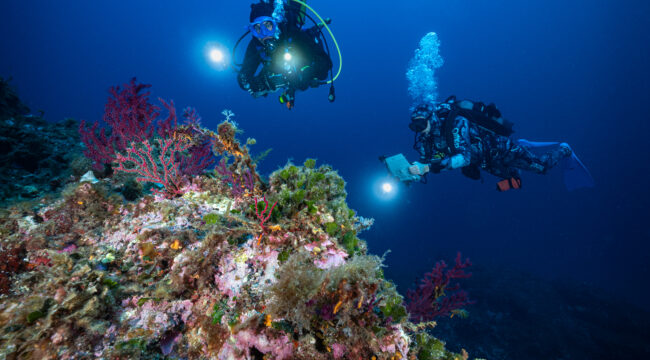TRAINING DESCRIPTION
Target audience and requirements
Anyone wishing to carry out professional work in hyperbaric environments at depths of up to 50 meters.
To complete Class 2 Mention B training, trainees must demonstrate that they:
- be over 18 years of age,
- are medically fit for hyperbaric diving in the desired class and category for less than one year,
- hold the minimum diving certification: PA60 minimum (Level 3),
- possess the Class 1 Hyperbaric Certification B.
In addition to the above administrative requirements, the trainee must demonstrate their progress in terms of autonomy at a depth of – 50 meters.
A reduction in training is possible, reducing the training from 70 hours (10 days) to 35 hours over 5 days. Those eligible for this reduction must certify:
- Level 4 or dive guide, or
- State or federal diving instructor certification.
Accessibility :
The doctor issuing the hyperbaric work aptitude certificate may or may not authorize access to the training course.
For all requests for training and accessibility for people with disabilities, the trainee must contact our training manager.
Training content
Training in hyperbaric risk prevention will focus on the following educational objectives :
- Topic 1 (Theory) : Theoretical knowledge of regulatory provisions,
- Topic 2 (Theory) : Theoretical knowledge related to professional activity,
- Topic 3 (Theory and Practice) : Materials and equipment,
- Topic 4 (Theory and Practice ): Organization of interventions,
- Topic 5 (Theory and Practice) : The various intervention procedures,
- Topic 6 (Practice in a natural environment) : Mastery of intervention procedures down to -50 meters,
Monitoring and evaluation system
Trainees must arrive prepared and trained for the course.
The CAH 2 mention B course is a deep diving course. Candidates must be up to date with their Class IB/PA60 technical and theoretical skills when they start the course. It is strongly recommended that you have dived within the last 15 days and have performed assistance ascents with an instructor before starting the course. It is essential that you are comfortable with your diving configuration. Your personal diving equipment configuration must be suitable and you must be proficient in its use.
An initial assessment will be carried out to verify practical prerequisites.
Continuous assessment will verify the acquisition of the targeted skills and the trainee’s ability to implement safety measures relating to hyperbaric exposure. A personalized trainee tracking sheet will be used to verify that the trainee has performed the various functions that they are likely to perform during their professional life during the practical training sessions carried out during the training. It will be used as a reference to discuss each trainee’s progress with the training team.
A training evaluation form will be completed by the trainer(s) during the training course for each trainee and may be consulted at any time.
The training evaluation will include a written test to assess the trainee’s knowledge and a practical test involving the rescue of a diver in difficulty.
Participants who have satisfied the requirements of the certification tests will be issued with the Hyperbaric Aptitude Certificate in accordance with the current model and their individual booklet.
In the event of failure, more comprehensive training will be offered to the trainee in order to cover the topics they have not mastered. A new exam will be organized.
The CAH must be renewed every 5 years by means of a refresher exam. The refresher exam must be initiated by the CAH holder in the year preceding the expiry date of their certificate.
Teaching and technical resources
The trainers structure the training around teaching materials and case studies, as well as professional scenarios in a natural environment. The training will be heavily focused on techniques used in scientific diving.
The theoretical training portion will take place in a classroom equipped with audiovisual equipment suitable for the number of trainees. Trainees will be provided with documents such as:
- Welcome booklet,
- course materials,
- Hyperbaric Safety Manual,
- Safety Data Sheet,
- Job description for supervisory staff and trainees.
The practical training part will take place from the port of Pointe Rouge. Dives beyond 20 meters will take place from support vessels (vessels: the CroMagnon, a 12-meter wooden pinasse, or the Astragal, a 9-meter aluminum semi-rigid boat) equipped with emergency equipment. Rescue equipment and access to it will be presented to candidates. Scuba diving equipment and Personal protective equipment will be provided to trainees. Scientific measuring equipment may be used to show trainees how to use it.
Immersion area : Marseille and surrounding area, Calanques sector, Frioul Islands.
The training will take place at Septentrion Environnement’s facilities and will focus on practical professional scenarios and various educational and technical workshops. Group work will be encouraged.
In addition to basic equipment (mask, fins, boots, computer, regulator, towel, water bottle, cap, etc.), trainees are required to bring the following specific equipment for this course:
- thermal protection suitable for deep diving in the Mediterranean (13°C to 19°C below the thermocline depending on the season),
- a parachute with a valve on a spool or reel, minimum 15 meters,
- a vest suitable for carrying a decompression tank (with metal rings),
- a multi-gas computer with NITROX management,
- a cutting tool such as a knife or wire cutter,
- an underwater wrist board,
- Optional : a 4 to 7 liter decompression tank equipped with a second stage, a pressure gauge, and a direct system.
This equipment can be rented (subject to availability) from the Septentrion Environnement diving school upon prior request.
Useful contacts
For any questions regarding training:
formations@septentrion-env.com
For any financial questions (once your training has been completed):
contact@septentrion-env.com
List of trainers:
Solène Basthard-Bogain, Educational Advisor, Trainer, Employee of SEPTENTRION ENVIRONNEMENT
Olivier Bianchimani, Training Manager and Hyperbaric Prevention Advisor, SEPTENTRION ENVIRONNEMENT employee
Carla Di Santo, Trainer, SEPTENTRION ENVIRONNEMENT employee
Michèle Leduc, External Trainer, EIH
